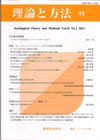Volume 22, Issue 1
Displaying 1-9 of 9 articles from this issue
- |<
- <
- 1
- >
- >|
Association Prize Acceptance Speech
-
2007Volume 22Issue 1 Pages 1-16
Published: 2007
Released on J-STAGE: August 03, 2007
Download PDF (363K)
Articles
-
2007Volume 22Issue 1 Pages 17-30
Published: 2007
Released on J-STAGE: August 03, 2007
Download PDF (256K) -
2007Volume 22Issue 1 Pages 31-48
Published: 2007
Released on J-STAGE: August 03, 2007
Download PDF (241K) -
2007Volume 22Issue 1 Pages 49-70
Published: 2007
Released on J-STAGE: August 03, 2007
Download PDF (227K) -
2007Volume 22Issue 1 Pages 71-86
Published: 2007
Released on J-STAGE: August 03, 2007
Download PDF (424K) -
2007Volume 22Issue 1 Pages 87-103
Published: 2007
Released on J-STAGE: August 03, 2007
Download PDF (233K)
Letters
-
2007Volume 22Issue 1 Pages 105-108
Published: April 30, 2007
Released on J-STAGE: March 27, 2009
Download PDF (167K)
Book Reviews Special
-
2007Volume 22Issue 1 Pages 109-120
Published: April 30, 2007
Released on J-STAGE: March 27, 2009
Download PDF (239K)
Book Reviews
-
2007Volume 22Issue 1 Pages 121-136
Published: April 30, 2007
Released on J-STAGE: March 27, 2009
Download PDF (412K)
- |<
- <
- 1
- >
- >|
